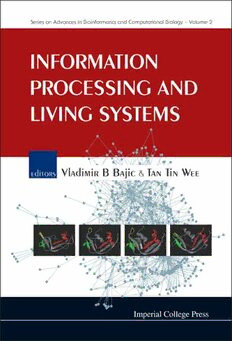
Information Processing and Living Systems PDF
799 Pages·2005·43.03 MB·English
Most books are stored in the elastic cloud where traffic is expensive. For this reason, we have a limit on daily download.
Preview Information Processing and Living Systems
Description:
Information processing and information flow occur in the course of an organism's development and throughout its lifespan. Organisms do not exist in isolation, but interact with each other constantly within a complex ecosystem. The relationships between organisms, such as those between prey or predator, host and parasite, and between mating partners, are complex and multidimensional. In all cases, there is constant communication and information flow at many levels. This book focuses on information processing by life forms and the use of information technology in understanding them. Readers are first given a comprehensive overview of biocomputing before navigating the complex terrain of natural processing of biological information using physiological and analogous computing models. The remainder of the book deals with artificial processing of biological information as a human endeavor in order to derive new knowledge and gain insight into life forms and their functioning. Specific innovative applications and tools for biological discovery are provided as the link and complement to biocomputing. Since artificial processing of biological information is complementary to natural processing, a better understanding of the former helps us improve the latter. Consequently, readers are exposed to both domains and, when dealing with biological problems of their interest, will be better equipped to grasp relevant ideas. Contents: A Multi-Disciplinary Survey of Biocomputing: Molecular and Cellular Levels; A Multi-Disciplinary Survey of Biocomputing: Systems and Evolutionary Levels, and Technological Applications; Models for Complex Eukaryotic Regulatory DNA Sequences; An Algorithm for Ab Initio DNA Motif Detection; Detecting Molecular Evidence of Positive Darwinian Selection; Molecular Phylogenetic Analysis: Understanding Genome Evolution; Constructing Biological Networks of Protein Protein Interactions; Computational Modelling of Gene Regulatory Networks; Overview of Text-Mining in Life Sciences; Integrated Prognostic Profiles: Combining Clinical and Gene Expression Information through Evolving Connectionist Approach; Databases on Gene Regulation; On the Search of Better Validation and Statistical Methods in Microarray Data Analysis; Information Extraction from Dynamic Biological Web Sources; Computer Aided Design of Signaling Networks; Analysis of DNA Sequences: Hunting for Genes; Biological Databases and Web Services: Metrics for Quality.
See more
The list of books you might like
Most books are stored in the elastic cloud where traffic is expensive. For this reason, we have a limit on daily download.
